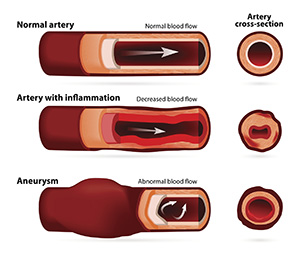What is an aortic aneurysm?
The largest artery in the body, the aorta is the primary blood vessel. It's responsible for carrying oxygen-rich blood away from the heart, throughout the abdomen, and to all parts of the body.
An aortic aneurysm is an abnormal enlargement, or bulging, of the wall of the aorta. The walls of the aorta are elastic and filled with blood at high pressure. Because of this pressure, the aorta can become stretched and weakened, resulting in swelling or the formation of a balloon-like blister, or sac.
If an aneurysm ruptures or tears, life-threatening internal bleeding can result. Fortunately, if detected in time, an aneurysm may be repaired with surgery and minimally invasive, nonsurgical techniques.

An overview of the aorta
The aorta has the following segments:
- Ascending aorta: The section that starts at the left ventricle of the heart (the aortic root) and continues up to the arch of the aorta.
- Arch of the aorta: The crest of the aorta, which is shaped like an upside-down "U."
- Descending aorta: The section that continues from the arch through the chest, to the common iliac arteries.
The descending aorta has two parts:
- The thoracic aorta runs through the chest, above the diaphragm. Aneurysms in this section of the aorta (including the aortic root, ascending aorta, aortic arch or top half of the descending aorta) are called thoracic aortic aneurysms.
- The abdominal aorta is the lower half, continuing below the diaphragm. Aneurysms in this section of the aorta are called abdominal aortic aneurysms.
Aneurysms involving both parts of the descending aorta are called thoracoabdominal aortic aneurysms.